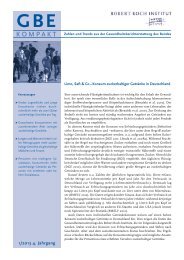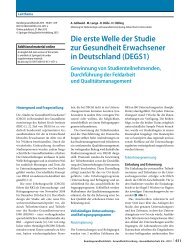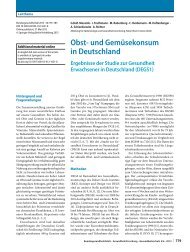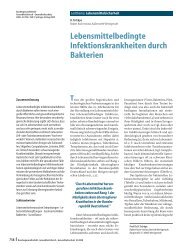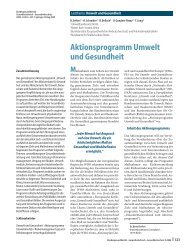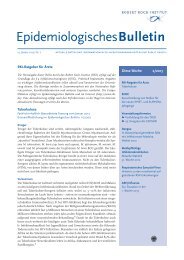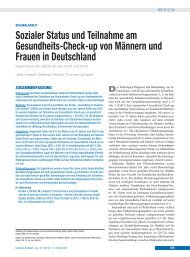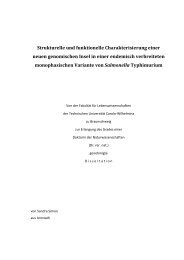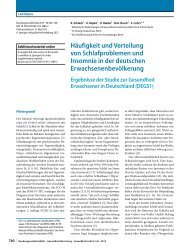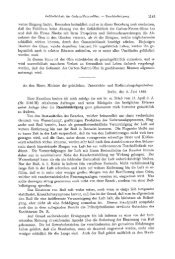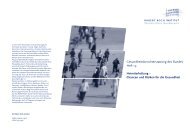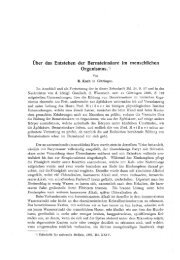Personale, familiäre und soziale Schutzfaktoren und ... - RKI
Personale, familiäre und soziale Schutzfaktoren und ... - RKI
Personale, familiäre und soziale Schutzfaktoren und ... - RKI
Erfolgreiche ePaper selbst erstellen
Machen Sie aus Ihren PDF Publikationen ein blätterbares Flipbook mit unserer einzigartigen Google optimierten e-Paper Software.
Abstract<br />
<strong>und</strong> <strong>soziale</strong>n Ges<strong>und</strong>heitszustand von<br />
Kindern <strong>und</strong> Jugendlichen über das gesamte<br />
Altersspektrum von 0–17 Jahren zu<br />
erheben. Die teilnehmenden Kinder <strong>und</strong><br />
Jugendlichen wurden u. a. medizinischphysikalisch<br />
untersucht <strong>und</strong> getestet, die<br />
Eltern, ab 11 Jahren auch die Kinder <strong>und</strong><br />
Jugendlichen selbst, schriftlich befragt.<br />
Zusätzlich wurde mit den Eltern ein standardisiertes<br />
computergestütztes ärztliches<br />
Interview (CAPI) durchgeführt <strong>und</strong> auf<br />
der Basis gewonnener Blut- <strong>und</strong> Urinproben<br />
eine umfangreiche Labordiagnostik<br />
durchgeführt. Details des Untersuchungsdesigns<br />
wie Stichprobenziehung, Studiendurchführung<br />
<strong>und</strong> Ablauf, Datenmanagement,<br />
Qualitätssicherung, Messung des<br />
Sozialstatus <strong>und</strong> Einbeziehung von Migranten<br />
können den Beiträgen in der Doppelausgabe<br />
Mai/Juni 2007 des B<strong>und</strong>esges<strong>und</strong>heitsblattes<br />
entnommen werden. Das<br />
vollständige Doppelheft steht als pdf-<br />
Download kostenfrei zur Verfügung unter:<br />
http://www.kiggs.de/experten/erste_<br />
ergebnisse/Basispublikation/index.html.<br />
Erfassung chronischer Krankheiten<br />
im KiGGS<br />
Informationen zu chronischen Krankheiten<br />
wurden im KiGGS durch Befragung<br />
sowohl in den schriftlichen Selbstausfüllfragebögen<br />
als auch durch die computergestützte<br />
ärztliche Befragung des<br />
begleitenden Elternteils, über die Erfassung<br />
von Körpermesswerten <strong>und</strong> durch<br />
Laboruntersuchungen erhoben. Die entsprechenden<br />
Fragen im CAPI lauteten:<br />
„Hat oder hatte ihr Kind jemals die Krankheit<br />
X?“, „Wenn ja, wurde diese Krankheit<br />
von einem Arzt festgestellt?“ Dabei wurde<br />
außer der Lebenszeitprävalenz u. a. auch<br />
die 12-Monats-Prävalenz erfragt.<br />
H. Hölling · R. Schlack · A. Dippelhofer · B.-M. Kurth<br />
Personal, familial and social resources and health-related quality of<br />
life in children and adolescents with chronic conditions<br />
Abstract<br />
Introduction The present publication<br />
describes chronic conditions of children and<br />
adolescents (asthma, ADHD, obesity) in<br />
relation to personal, familial and social resources<br />
and to health-related quality of life<br />
(HRQOL). A database of these investigations<br />
is the German health interview and examination<br />
survey of children and adolescents<br />
(KiGGS), which is representative for 0 to 17<br />
year-olds. The above mentioned chronic<br />
conditions occur frequently in this age<br />
group and are assumed to have an influence<br />
on quality of life and to be related to a<br />
lower level of protective factors. Methods<br />
The investigations used the data of 6813<br />
children and adolescents within the age<br />
group of 11 to 17 who participated in the<br />
KiGGS study. Information about diagnosed<br />
chronic conditions was given by the parents<br />
within the framework of the computerassisted<br />
medical interview (CAPI) and by<br />
completing questionnaires. The personal,<br />
familial and social protection factors as well<br />
as the quality of life were assessed by the<br />
questionnaires, filled in by the adolescents<br />
themselves. Instruments used were the<br />
Social Support Scale, the Family Climate<br />
Scale and KINDL-R. Results Children and<br />
adolescents with asthma seem to have no<br />
deficits in the health-related quality of life<br />
and in the field of protective factors. This<br />
differs from the situation of the obese chil-<br />
dren as well as from the children with<br />
ADHD. Both groups show significant deficits<br />
in the health-related quality of life and<br />
protection factors. Discussion The chronic<br />
conditions investigated show remarkable<br />
differences in the scale values for measuring<br />
protective factors and health-related quality<br />
of life. Possible explanations are: For asthma<br />
as a chronic disease with somatic manifestation<br />
effective treatments and therapies<br />
exist, so that it has nearly no influence on<br />
the self-assessed quality of life. ADHD and<br />
obesity result in a decrease of quality of life<br />
and in the field of protective factors, possibly<br />
caused by social stigmatisation, isolation<br />
and demotivation of the concerned children<br />
and adolescents. Therefore it is important to<br />
support those children and adolescents to<br />
cope with their disease-related problems.<br />
The results illustrate that in addition to the<br />
immediate effects of chronic conditions on<br />
the concerned children and their families, it<br />
is the quality of life and the familial and<br />
social environment that should be specifically<br />
addressed in further studies.<br />
Keywords<br />
health survey · children · adolescents ·<br />
chronic disease · asthma · obesity · ADHD ·<br />
health-related quality of life · protective<br />
factors<br />
Asthma<br />
Die in der vorliegenden Arbeit herangezogenen<br />
Informationen zu Asthma stammen<br />
aus dem CAPI. Für die Auswertungen<br />
wurde die 12-Monats-Prävalenz<br />
herangezogen. Diese wurde folgendermaßen<br />
bestimmt: Wenn im CAPI angegeben<br />
wurde, dass Asthma in den letzten 12 Monaten<br />
aufgetreten war <strong>und</strong>/oder für<br />
denselben Zeitraum eine spezifische Medikamenteneinnahme<br />
berichtet wurde,<br />
galt ein Teilnehmer als „aktuell“ (in den<br />
B<strong>und</strong>esges<strong>und</strong>heitsbl - Ges<strong>und</strong>heitsforsch - Ges<strong>und</strong>heitsschutz 6 · 2008 |<br />
609



